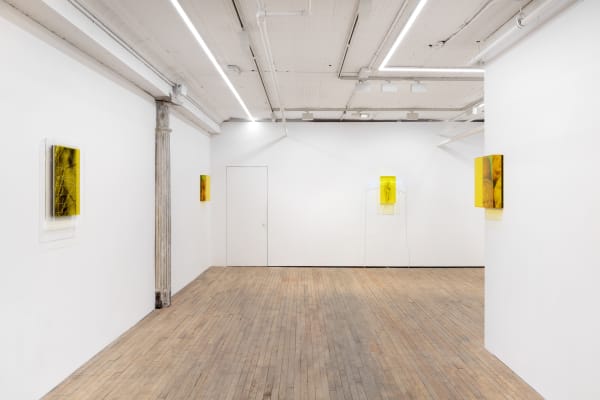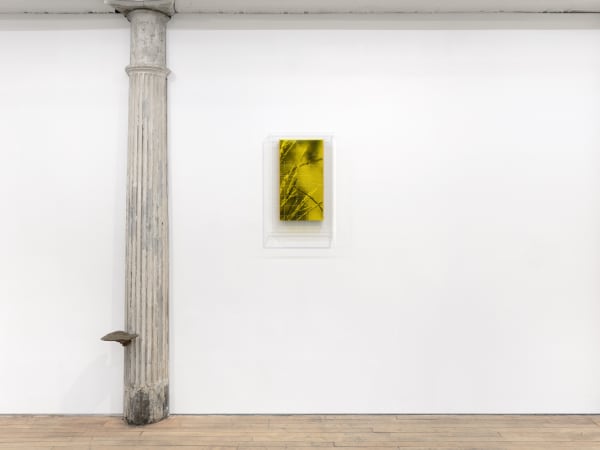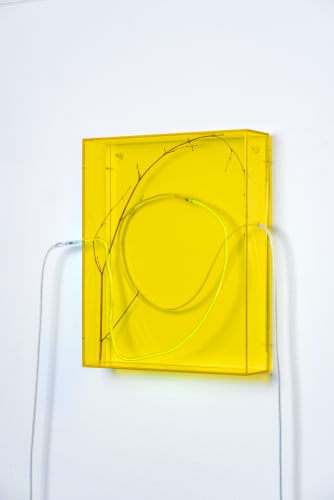Saskia Noor van Imhoff: Grafting
GRIMM is pleased to present a showcase of recent works by Dutch artist Saskia Noor van Imhoff, opening January 20, 2022 at our New York gallery.
Saskia Noor van Imhoff sees the world as an organic system of connections determined by visible and invisible structures. Her practice engages the overarching architecture surrounding our existence and incorporates modes of selection, curation, and preservation of works and collections: considerations that inform the ascribing of value and produce appreciation and (re)presentation of art.
Recently, Van Imhoff has shifted her practice away from the framework of the traditional studio towards an open-air studio in a Dutch polder landscape. Her studio inhabits a strip of land that prior to her arrival was subject to neglect. The plot was mainly used as a dumping ground for various leftover materials. These circumstances provided the artist with the possibility to further expand on her interest in traces and remnants. Since arriving, she has been digging and planting, sanitizing the soil and creating a space that is fit for cultivation. During this process she discovered vestiges of former use. Throughout she has been documenting and archiving her findings, activities, and own additions.
Examining the growth of plant life and the evidence of past activity embedded in the soil, van Imhoff studies the story the earth tells of human and nonhuman interactions. The artist interprets and complements this with archival materials such as maps and historical documents, which has informed her understanding of the terrain and contributes to a layered, visual representation of the property. The way in which the artist advances alternate systems of referencing the bounded area that belongs to her, brings into question how property and ownership is signified. Does the division of land by lines, or borders, produce a sense of ownership? Or, in the case of neglected or undeveloped land, why is it attributed with a sense of emptiness, subject to a different set of values from that which is “owned”?
The works now presented at GRIMM are part of this ongoing research. Driven by the conceptual and historical significance of objects and places, the works examine the growth of plant life and the evidence of past activity embedded in the soil. Grafting, the act of transplanting one part of a plant onto another, holds deep interest for Van Imhoff as a metaphor for the progress of culture. She sees the manipulation of the landscape as a kind of grafting, deepening the relationship between people and place, a relationship through which the concept of nature is borne.
Van Imhoff conceives her process as marking a moment in time, a temporary combination of materials and circumstance which will inevitably undergo further permutations. Among the materials she uses, Perspex, photography, glass, neon lighting, and found objects are all appropriated to create new systems. By placing the various materials together, contradictions disappear and new connections arise.
About the artist:
Saskia Noor van Imhoff (b. 1982 in Mission, CA) lives and works in Amsterdam (NL). She received her BA in Fine Art from the Gerrit Rietveld Academie in Amsterdam (NL) in 2008. She worked at De Ateliers, Amsterdam (NL) in 2012, and Künstlerhaus Bethanien, Berlin (DE) in 2014. Van Imhoff was awarded the ABN Amro Art Prize (NL) in 2017, the same year she was nominated for the Prix de Rome (NL). She received the Walter Tielmann Prize for Book Design (DE) in 2012 and the Gerrit Rietveld Academie Prize (NL) in 2008.
Van Imhoff has had exhibitions at various venues including: Centraal Museum, Utrecht (NL); the Arnulf Rainer Museum, Baden (AT); the 11th Gwangju Biennial (KR); Centre Georges Pompidou, Paris (FR); Frans Hals Museum|DeHallen, Haarlem (NL); Stedelijk Museum, Amsterdam (NL); De Appel, Amsterdam (NL) and the Moscow Biennial (RU).
Selected collections include Stedelijk Museum, Amsterdam (NL); Museum Voorlinden, Wassenaar (NL); Verbeke Foundation, Kemzeke (BE); ING Art Collection, Amsterdam (NL); The Ekard Collection; De Nederlandsche Bank, Amsterdam (NL);TextielMuseum, Tilburg (NL); AMC Art Collection, Amsterdam (NL); Akzo Nobel Art Foundation, Amsterdam (NL) and ABN Amro Art Collection, Amsterdam (NL), among other public and private collections.







